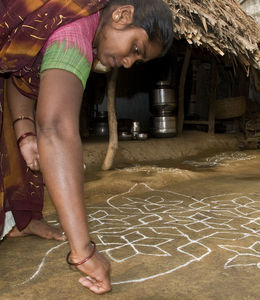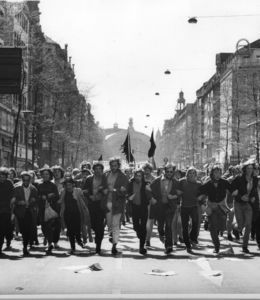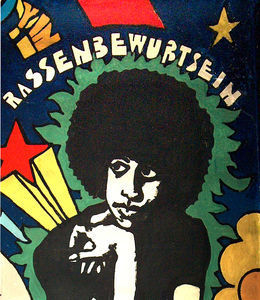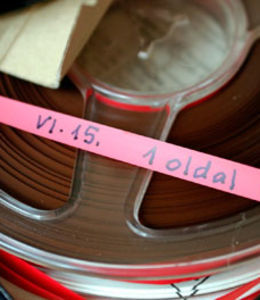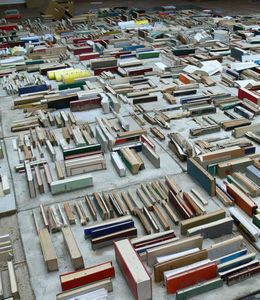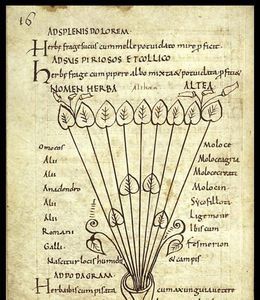Vera and Donald Blinken Open Society Archives
2008
Etikoppaka is a village with about 12,000 inhabitants in Andhra Pradesh in South-East India, near the city of Visakhapatnam. Mahatma Gandhi visited this village in 1930 on the invitation of his friend, the freedom fighter C.V. Narasimha Raju, who belonged to a family of Etikoppaka’s feudal landlords. C.V.N. Raju understood and accepted Gandhi’s ideal of trusteeship, which the Mahatma (the Great Soul) proposed to the rich; so he founded India’s first sugar cane cooperative, initiating an India-wide movement which has made India the largest producer of sugar in the world.
In 1989, one of the descendents of the Raju family, C. V. Raju, founded a new cooperative – Padmavathi Associates to revive a craft for which the village of Etikoppaka was traditionally famous: the manufacture of turned-wood objects coated with vegetable dyes...
The 25 photos in the exhibition were taken and selected especially for the East-European Goethe Institutes by Barbara Klemm, one of the most important documentary photographers of the German student movements. Klemm covered East- and West-German political and social events as a photographer for the Frankfurter Allgemeine Zeitung. Over the years she has received various awards as a result of her outstanding work and in recognition of her direct and original photos.
After the opening Paul Hockenos and Gábor Klaniczay will be discussing the year 1968. (in English, without translation)
Paul Hockenos is a writer and political analyst. He now lives in in Berlin, and concentrates mainly on Germany and South-Eastern Europe. His most recent book is Joschka Fischer and the Making of the Berlin Republic: An Alternative...
The secession: 1966 - 1968 - 1972. The wars in Vietnam and in the Middle East; the cultural revolution in China, accompanied by the spread of Maoism and neo-Trotskyism; the events of 1968 in Paris and Prague, followed by the invasion of Czechoslovakia; the student movements and rebellions in North and Central America; the emergence and practical consequences of the notion of a post-industrialist, consumer society; the concept and reality of alienation; the elevation of structuralism to a religion; the effects of the hippie movement, rock music and drugs on culture; the spirit and practice of counter-culture and the underground; and all these in conjunction with the beginning, and the almost immediate failure, of the Hungarian economic reforms and the process of consolidation in Hungary: all these together posed an unprecedented...
To commemorate the 50th anniversary of the trial by People's Jury of Imre Nagy and his fellow defendants, OSA Archivum, jointly with the 1956 Institute, is organizing an unusual, one-week-long event.
When Imre Nagy and his associates were tried in June 1958, the sound technicians of the Ministry of the Interior operated two tape recorders in the courtroom. From the first day of the trial right up to the submission of the appeal for clemency, they recorded the entire proceedings, which included the cross-examination of the accused and the witnesses, the case for the prosecution, the defense attorney’s speech and the defendants’ final statements. In 1990 the tapes of the 52-hour-long recording were transferred from the Supreme Court to the Hungarian National Archives, where...
János Hübler and Nemere Kerezsi, two Ph. D. students at the Budapest Academy of Fine Arts (supervisor: György Jovánovics), have created this installation using two cubic meters of concrete and eighteen cubic meters of discarded books. Originally part of a large collection donated to the Central European University by Radio Free Europe’s research institute, the books, most of which had lost all relevance in the meantime, were offered to the public gratis. The eighteen cubic meters of books used for the installation are actually the leftovers, unwanted by the public. The two artists executed the project with the help of Márta Rácz. The books were built into a concrete foundation regardless of their content. Arranged with their spines pointing downwards, they constitute interesting shapes of various heights, due to their different sizes...
Along with Freud, Nietzsche and Max Weber, the German art historian and cultural expert Abraham Moritz Warburg (1866–1929) is regarded as one of the most important pioneers of the humanities in the 19th and early 20th centuries. Aby Warburg – "Jewish by birth, a Hamburger at heart, with the soul of a Florentine" (Warburg's description of himself) – established iconology as a new method and as a branch of art history in its own right. The library he founded, the "Kulturwissenschaftliche Bibliothek Warburg", which encompassed some 60,000 volumes at his death, was a gift to scholarship of reference materials that are of timeless value for research on the Italian and German Renaissance.
Warburg's Mnemosyne Atlas brought together graphical materials from his research and lectures in a series of large-format plates on various topics...
“In the remote pages of a certain Chinese encyclopedia entitled 'Celestial Empire of benevolent Knowledge' it is written that the animals are divided into: (a) belonging to the emperor, (b) embalmed, (c) tame, (d) sucking pigs, (e) sirens, (f) fabulous, (g) stray dogs, (h) included in the present classification, (i) frenzied, (j) innumerable, (k) drawn with a very fine camelhair brush, (l) et cetera, (m) having just broken the water pitcher, (n) that from a long way off look like flies.”
(The Analytical Language of John Wilkins by Jorge Luis Borges)
OSA Archivum, in collaboration with the Budapest Zoo, is organizing an exhibition on the relationship between classification/taxonomy and the archive. The show presents three layers of the archive and the corresponding system/logic of classification:
1. The...


